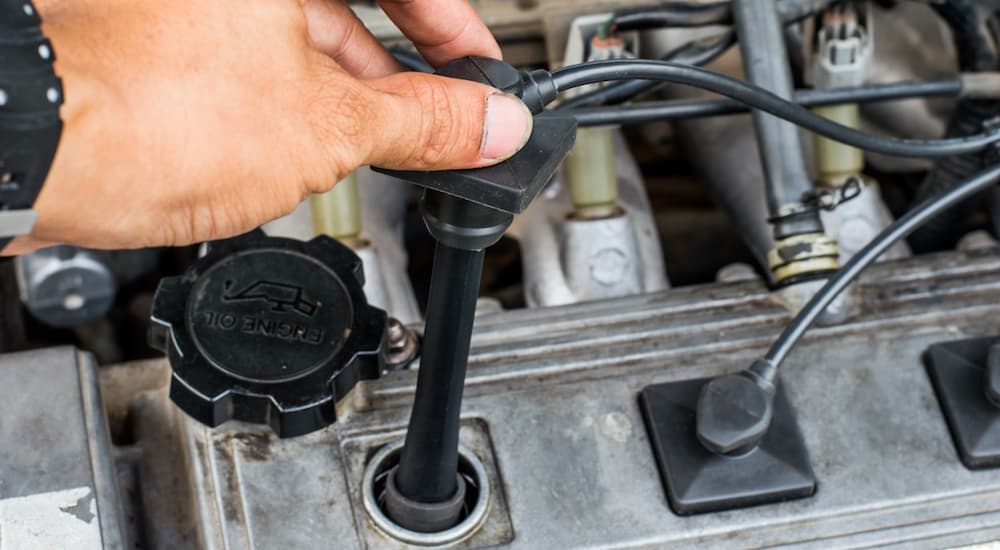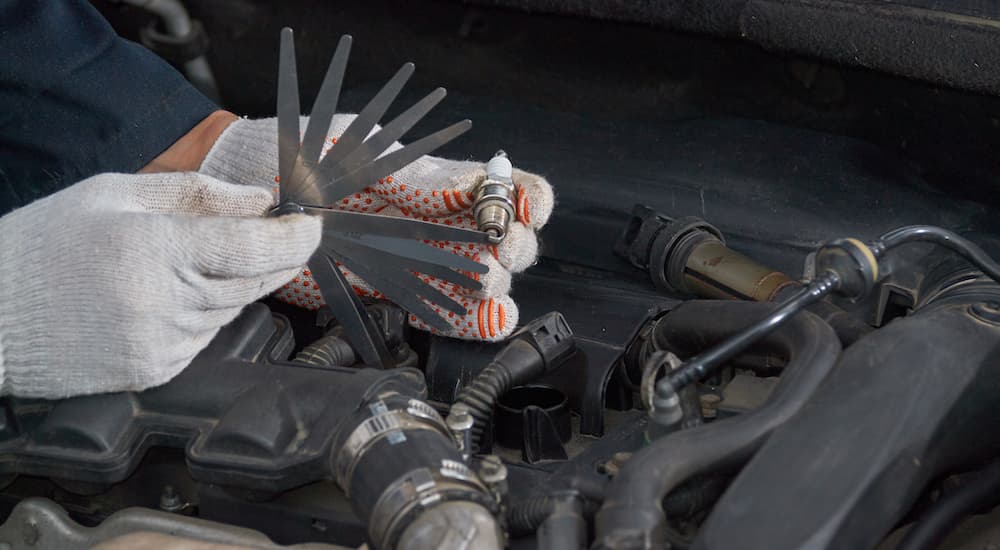As the ignition source for the entire internal combustion process, spark plugs are an integral part of your vehicle’s engine. They’re also often one of the first components under the hood that will need to be replaced, with older designs lasting as little as 10,000 miles. Luckily replacing your spark plugs is one of the easier repair tasks you’ll face, requiring little more than some common tools, new spark plugs, and a little lubricant. That’s not to say it’s a walk in the park, as narrowing down which spark plug needs to be replaced can be a task unto itself. This is where inline spark testers come in. These simple tools, which can usually be found for no more than $20, make a valuable addition to any D.I.Y. mechanic’s toolbox, allowing drivers to quickly diagnose ignition issues without the hassle––or cost––of visiting an auto repair shop. Below we’ll examine some common reasons why spark plugs wear out, signs and symptoms of a failing or broken spark plug, and finish up with a step-by-step guide outlining how to use an inline spark tester.
Spark Plug 101
There are many reasons spark plugs might wear out, including normal wear and tear. At the tip of every spark plug is an electrode, a small gap, and a ground electrode. When an electric current is fed to a spark plug from the ignition coil, the current jumps the gap between the electrodes, producing a spark that’s used to ignite the air/fuel mixture that powers the engine. Every time a spark is produced, a tiny amount of material burns off the tip of the electrode, which over time, will eventually result in a gap that’s too wide for the spark to jump. It’s not a fast process–the average spark plug will fire hundreds of million times in its lifespan––but it is inevitable.
Drivers looking to maximize vehicle performance should follow a set schedule for replacing spark plugs because even though they still might technically be functioning, worn plugs can have a noticeable effect on engine performance and fuel efficiency. The ignition coil can help out to an extent––sending a higher voltage to the worn plug to help bridge the gap––but eventually, a replacement will be in order.
Overheating is another factor that can also cause the electrode to wear out at an accelerated rate. This can be caused by a number of factors, including pre-ignition or a poorly functioning cooling system. Pre-ignition occurs when a cylinder ignites at the wrong time, throwing off the engine’s timing and leading to some potentially serious damage. This is due to a particularly hot element within the cylinder––usually an exhaust valve, carbon residue, or the spark plug itself––providing enough heat to create a combustion reaction without the spark plug ever firing. Overheating doesn’t only cause an electrode to wear out prematurely but can even warp or melt parts of the cylinder or engine block.
In addition to the electrodes wearing out, spark plugs can also simply become too dirty to work properly. Oil is one of the most essential fluids in any vehicle, but oil showing up in the wrong place can result in some real headaches. This is especially true of your engine’s combustion chamber, which in theory shouldn’t contain anything but air and fuel. When oil starts to seep into the combustion chamber, it can coat the tip of the spark plug, making for an irregular ignition cycle––or possibly no ignition at all. If your vehicle starts burning through oil at a higher rate than normal, your spark plugs could well be on their last legs, so keep an eye on that dipstick.
Carbon buildup is another common way to foul up a spark plug. This black, sooty residue can wreak havoc on a spark plug’s timing, leading to misfires, a lack of acceleration, and harder-than-normal ignition when you go to start up the engine. There are a number of factors that can cause this carbon buildup, including a rich fuel/air mixture from dirty fuel injectors or air filters. Certain driving habits, like chronically cruising along at low speeds or leaving your vehicle idling for extended periods of time, can also contribute to these annoying carbon deposits.
Lastly, the way the spark plug was installed can affect performance. Spark plugs need to be correctly seated in the cylinder head to properly dissipate heat, but this can be a tricky maneuver to pull off by feel alone. Use a torque wrench and follow the guidelines found on the spark plug packaging to ensure it’s properly installed, or you could be looking at some serious pre-ignition issues or reduced performance.

Signs of a Faulty Spark Plug
Faulty or worn-out spark plugs can have a noticeable effect behind the wheel. From rough idling to decreased gas mileage or a failure to start altogether, there are a few tell-tale signs of a failing or broken spark plug to keep an eye out for.
Check Engine Light
The first and most obvious sign of a bad spark plug is the good old-fashioned check engine light. This will often manifest as a misfire-related error code, so keep an eye out for diagnostic trouble codes (DTC), including PO300 through PO312. PO300 is the DTC for a random misfire, and PO301 through PO308 describe misfires in specific cylinders related to the last number in the code (for example, a DTC reading PO304 would indicate a misfire in cylinder 4). Before the check engine light comes on, you might notice other symptoms of a misfire, including rough idling. Some misfires are small and irregular, and while they should be assessed ASAP, they aren’t likely to cause any immediate harm. A flashing check engine light is a whole different story and could cause major damage if not dealt with immediately.
Vehicle Won’t Start
If your vehicle isn’t starting up like it used to, this could be another indication of a bad spark plug. It takes a decent amount of juice to get a vehicle’s engine to turn over, and the task might be impossible if your spark plugs aren’t up to snuff. If your vehicle has trouble starting up after sitting idle for an extended period of time, take a hard look at your spark plugs or wires. A dead or dying battery can cause similar issues but usually manifests a bit differently. If the car begins to start but then stalls out, you’re probably looking at bad spark plugs or wires. If the vehicle won’t start at all and makes a clicking sound when you turn the key, or you notice that your in-vehicle electronics are dim or sluggish, you might be dealing with a drained battery.
Reduced Gas Mileage and Acceleration
If a spark plug is on the way out, you might find yourself pulling into the gas station more often than normal. This is due to the fact that worn-out spark plugs can’t effectively burn the fuel within the cylinder, reducing fuel efficiency and wasting gas to boot. This is no small thing, as a misfiring spark plug can reduce fuel economy by as much as 30 percent. Spark plugs nearing the end of their service life have a detrimental effect on fuel economy in general, which is why it’s so important to stick to the service schedule outlined by the manufacturer. Sluggish acceleration is another sign of some spark plugs that are past their prime, unable to produce a consistent enough spark for the vehicle to operate properly.
Rough Idle/Knocking
A vehicle that runs rough when idling can indicate any number of automotive issues, including failing spark plugs. When sparks don’t fire at regular intervals, the engine is thrown out of whack, producing a distinctive rumbling feeling within the passenger compartment. The effect is particularly noticeable on cold, wet mornings when condensation can build up in the cylinders and make the whole combustion process a little less smooth in general. Engine knocking is another indication of bad spark plugs. This usually occurs when accelerating the vehicle and is due to the fact that the fuel within the cylinder has not been ignited at the correct time, so make sure to listen for any unusual noises when you’re behind the wheel.
How to Use an Inline Spark Tester
Before we get into specifics, let’s take a quick look at the basic concept behind an inline spark tester. Your ignition coil sends an electrical current to each spark plug through a series of ignition wires. Each spark plug gets its own dedicated wire, which ignites the cylinders in a predetermined rotation to provide your vehicle with smooth, consistent power. The wires and the ignition coil itself are also prone to failure, so when dealing with ignition-related issues, remember that the spark plugs themselves aren’t always the culprit.
An inline spark tester is essentially a lightbulb with electrical connections on either end. By plugging this tool in between where the ignition wire normally connects to the spark plug itself, you can easily tell if a spark plug is receiving power by checking to see if the bulb is illuminated.
There are a couple different types of inline spark testers on the market. Basic designs feature a bulb to indicate if the spark plug is firing, but it won’t actually tell you how strong of a spark it’s producing. On some higher-end models, you can adjust the tester to measure a certain amount of kilovolts, but since most vehicles need at least 10 kilovolts to ignite, don’t set the threshold any lower than that.
There are also two types of inline spark testers based on your vehicle’s design. Some engines feature spark plugs that conveniently poke right out the top of the cylinder head. These non-recessed spark plugs are easy to access as the end of the spark tester can be fitted right on top of the plug. Recessed plugs with coil on plug ignition require spark testers with a plastic boot, which is inserted into the hold until you can feel it click onto the plug. Many inline spark tester kits come with the boot attachment, so consult your vehicle’s manual to determine if you need this extra accessory.
Now let’s examine the process step-by-step.
- With the vehicle turned off, pop the hood and use a wrench to disconnect the negative terminal from the battery. While this isn’t strictly necessary, it’s always a good safety precaution when working on any part of your vehicle’s electrical system.
- Find the black ignition wires that connect to the top of each cylinder head. There will be eight ignition wires in a vehicle with a V8 engine, six on a V6, and so on. Remove the end of the ignition wire, called the boot, from the top of the spark plug by placing your thumb and index finger as close to the base of the wire as possible. Do not attempt to remove the ignition wire by gripping any part aside from the boot, as it can cause damage. There are special tools available to help remove ignition wires, though in most cases, it’s an easy enough task.
- Attach the end of the spark tester that looks like the boot of the ignition wire on top of the spark plug. For recessed spark plugs, insert the boot into the hole until you hear or feel it click onto the spark plug.
- Connect the other end of the spark tester to the ignition wire you previously disconnected from the spark plug. Your spark tester should now be connected to the ignition wire on one end and the spark plug on the other, completing the electrical circuit.
- Reconnect the negative battery terminal, but keep it loose because you’ll have to repeat this step for each individual spark plug.
- Start the vehicle and look at the bulb on the inline spark tester. If the spark plug is working properly, it should be lighting at regular intervals. If it doesn’t light up at all or only lights up irregularly, you’ve got a broken or failing spark plug on your hands. This could also indicate a broken ignition wire or faulty ignition coil.
- Repeat the process for each spark plug.

Testing Spark Plugs Is Simple, But Can Save You Money
Using an inline spark tester to assess your spark plugs is a great way to save some money and gain a better understanding of the inner workings of your vehicle. It’s a relatively simple process, requiring no special tools or extensive automotive know-how, making it the perfect starter project for any D.I.Y.-er. By narrowing down mysterious automotive issues from the comfort of your own garage you can cross some of the more obvious causes off the list before taking it to a shop and potentially avoid an expensive repair altogether.
Typically retailing for less than $20, an inline spark tester could very well pay for itself many times over. If you’re looking to make those spark plugs last as long as possible, remember the tips outlined above and, as always, follow the manufacturer’s recommended service schedule. Faulty spark plugs aren’t always the easiest issue to diagnose, as the symptoms are so similar to many other common mechanical issues, but the more you learn about your vehicle, the easier it is to head off smaller issues before they become big-ticket repairs.

